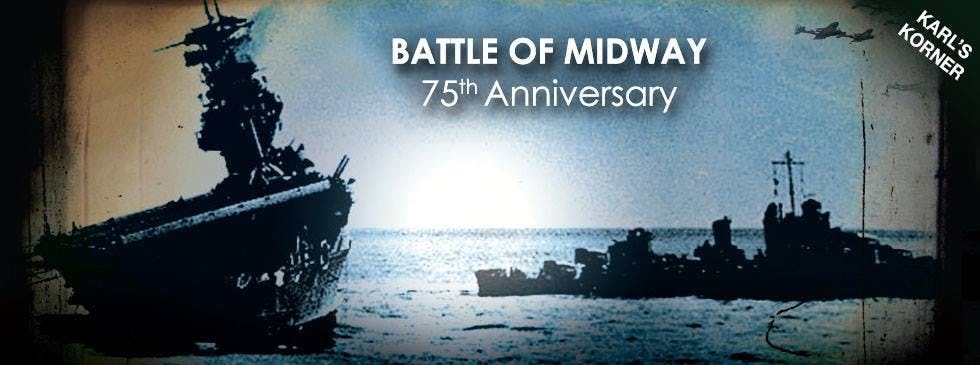 June 06, 2017 | Karl’s Korner
June 06, 2017 | Karl’s KornerThe Battle of Midway
Hello and welcome to this month’s “Karl’s Korner”, a historical segment written by myself, Karl Zingheim - Ship Historian of the USS Midway Museum! As we embark on a new month, we look back 75 years ago at a moment in history that changed the course of so many lives. This month, we recognize the 75th Anniversary of the Battle of Midway. This battle - fought between the June 3 and 7, 1942, not only defined the course of the rest of the war in the Pacific - it stands out as an extraordinary battle in several ways....
June 1942
First, it occurred because of unresolved strategy on the Japanese side. For decades, the presumed clash between the U. S. and Japanese fleets was expected by both sides to occur not far from Japan, after the U. S. fleet fought its way across the Central Pacific islands, suffering losses along the way, before the big showdown with the waiting main Japanese fleet. Instead, the war began with a surprise carrier attack on the U. S. Pacific Fleet in port at Pearl Harbor, while most of the rest of the Japanese Navy attacked in East Asia. Months later, the American carriers, missed during the original attack, were still a dangerous factor, and Hawaii remained a potent threat in the Central Pacific. From the Japanese standpoint, matters still needed to be settled in the Hawaiian region. The powerful American reaction to the Japanese move on Midway, which created the battle, was the result of brilliant intelligence work. In the 1920s, individual Navy radiomen took notice of Japanese naval radio traffic, and took it upon themselves to learn Japanese Morse Code, and, over time, work out how the Japanese communicated, even if the content of the messages was still mostly concealed by code. Eventually, the Navy’s officials endorsed this surveillance work, and prior to the war’s beginning, U. S. communications intelligence was well developed. With war raging in full fury, the Japanese were forced to rely on radio extensively to guide their far-flung operations, which only fed more samples for the American cryptographers to examine, and deduce what kind of operations followed. By April 1942, the analysts in Pearl Harbor were able to forecast an expected Japanese move against Port Moresby in New Guinea for early May. The resulting Battle of the Coral Sea made a firm believer out of Admiral Chester Nimitz, in command of the Pacific Fleet, and he put full stock in news of another Japanese move slated for the Hawaii region in June. This permitted the massing of forces on and around Midway in time for the coming battle, despite second-guessing from Washington. At the point of actual contact, the opposing forces were roughly equal in strength, which meant that small things could have major consequences in combat. The intermittent nature of reconnaissance meant that the commanders had fragmentary information on which to make decisions. This affected how the American strike groups were dispatched by the three carriers. Leaders had to guess where the Japanese would be when the planes actually arrived over their targets. Not everyone guessed correctly: the Hornet’s two dive bomber squadrons and accompanying fighters missed the Japanese, while her torpedo squadron went its own way and found them without any support to help draw off the defending fighters. The Enterprise’s torpedo planes only found the Japanese carriers because of the smoke screens used to help hide the carriers when the Hornet’s planes attacked just over the horizon. The Enterprise’s dive bombers succeeded only because a lone Japanese destroyer, left behind to keep a pesky submarine away, was found speeding to catch up to the carriers, and because the Japanese fighters were all down at water level chasing the Yorktown’s torpedo planes who happened to attack minutes before. Problems in getting a Japanese search plane launched meant that when it found the Yorktown’s task force, word arrived just as the Japanese fleet was readying a new strike on Midway, causing delay and confusion in arming the Japanese planes. This not only postponed a counterattack on the Yorktown, it led to a dangerous stacking of bombs and torpedoes on the carriers which made them especially susceptible to blast and fire damage. For example, the Akagi was demolished despite sustaining only one direct hit. Midway is also the definitive example of what aircraft brought to naval warfare. Because combat aircraft could now carry ordnance powerful enough to cripple and sink major warships, carriers supplanted battleships because the destructive reach of their air groups greatly out ranged heavy guns. This was suggested with the raid on the Italian fleet at Taranto, the crippling of the Bismarck, and verified by the raid on Pearl Harbor and the sinking of the Prince of Wales and Repulse by aerial attack in December 1941. Midway showed that airpower could decide even fleet actions, and no large naval clash in the Pacific during daytime was devoid of airpower. Midway was a decisive battle, but it is also a landmark example in how improvised strategy can create new difficulties, how intelligence work can produce a crucial edge, and how small matters can have a ripple effect that can determine how a battle may go. This is as true today as it was off Midway atoll 75 years ago. Thank you for reading! Launch em’... until next time, Karl
Your Adventure Starts Now
Your email is the key to information that will open up all your possibilities for exploring the mighty Midway!

